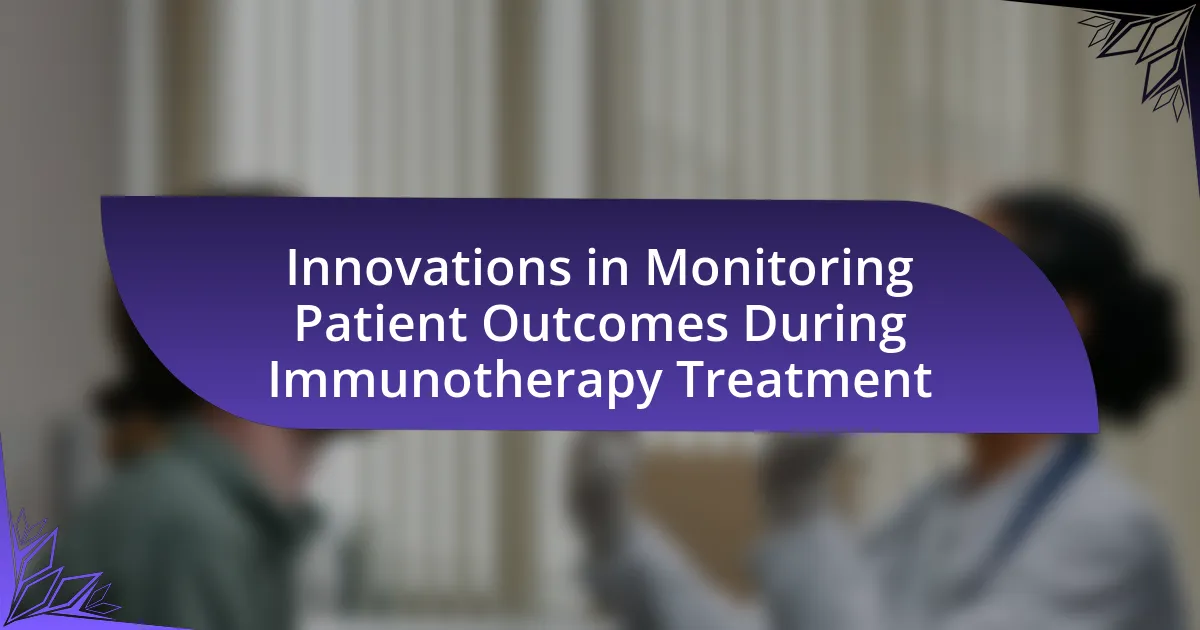Innovations in monitoring patient outcomes during immunotherapy treatment encompass real-time biomarker analysis, advanced imaging techniques, and digital health technologies. These advancements enable healthcare providers to assess immune responses, visualize tumor dynamics, and continuously monitor patient symptoms, thereby enhancing personalized treatment approaches. The article explores the evolution of monitoring techniques, the role of biomarkers, and the integration of artificial intelligence in predictive analytics, highlighting the critical importance of effective monitoring in optimizing patient management and improving treatment efficacy. Additionally, it addresses the challenges clinicians face in assessing patient responses and the strategies to enhance patient engagement in monitoring processes.

What are Innovations in Monitoring Patient Outcomes During Immunotherapy Treatment?
Innovations in monitoring patient outcomes during immunotherapy treatment include the use of real-time biomarker analysis, advanced imaging techniques, and digital health technologies. Real-time biomarker analysis allows for the assessment of immune responses through blood tests that measure specific proteins or cells, providing immediate feedback on treatment efficacy. Advanced imaging techniques, such as PET scans and MRI, enable clinicians to visualize tumor responses more accurately and assess changes in tumor metabolism. Digital health technologies, including mobile health applications and wearable devices, facilitate continuous monitoring of patient symptoms and quality of life, allowing for timely interventions. These innovations enhance personalized treatment approaches and improve overall patient management during immunotherapy.
How have monitoring techniques evolved in immunotherapy?
Monitoring techniques in immunotherapy have evolved significantly through the integration of advanced imaging technologies, biomarker analysis, and real-time data analytics. Initially, traditional methods relied heavily on clinical assessments and standard imaging techniques, which often lacked sensitivity in detecting early treatment responses. Recent advancements include the use of PET scans and MRI, which provide more precise visualization of tumor dynamics and immune responses. Additionally, the identification and quantification of specific biomarkers, such as PD-L1 expression and circulating tumor DNA, have enhanced the ability to monitor treatment efficacy and predict patient outcomes. These innovations enable clinicians to tailor immunotherapy approaches more effectively, improving overall patient management and outcomes.
What technologies are currently being utilized for patient monitoring?
Current technologies utilized for patient monitoring include wearable devices, telehealth platforms, and remote patient monitoring systems. Wearable devices, such as smartwatches and fitness trackers, enable continuous tracking of vital signs like heart rate and oxygen saturation. Telehealth platforms facilitate real-time consultations and monitoring through video calls and mobile applications, allowing healthcare providers to assess patient conditions remotely. Remote patient monitoring systems integrate various sensors and devices to collect health data and transmit it to healthcare professionals for analysis. These technologies enhance patient engagement and improve outcomes, particularly in immunotherapy treatment, by providing timely data and enabling proactive interventions.
How do these technologies improve patient outcome assessments?
Technologies such as digital health tools, artificial intelligence, and real-time monitoring systems enhance patient outcome assessments by providing precise, timely data on treatment responses and side effects. These innovations enable healthcare providers to track patient progress more accurately, allowing for personalized treatment adjustments based on individual responses. For instance, AI algorithms can analyze large datasets to identify patterns in patient outcomes, leading to improved predictive analytics. Studies have shown that real-time monitoring can reduce hospital readmission rates by up to 30%, demonstrating the effectiveness of these technologies in improving overall patient care and outcomes.
Why is monitoring patient outcomes critical during immunotherapy?
Monitoring patient outcomes is critical during immunotherapy because it enables healthcare providers to assess the effectiveness and safety of treatment in real-time. This ongoing evaluation helps identify both positive responses and adverse effects, allowing for timely adjustments to therapy. Research indicates that approximately 30% of patients experience immune-related adverse events, which can significantly impact treatment success and patient quality of life. By closely monitoring these outcomes, clinicians can optimize treatment plans, enhance patient safety, and improve overall therapeutic efficacy.
What challenges do clinicians face in assessing patient responses?
Clinicians face several challenges in assessing patient responses during immunotherapy treatment, primarily due to the variability in individual patient reactions and the complexity of immune responses. This variability can lead to difficulties in determining the effectiveness of treatment, as some patients may experience delayed responses or atypical side effects that do not align with traditional assessment metrics. Additionally, the lack of standardized biomarkers for evaluating responses complicates the assessment process, making it challenging for clinicians to interpret results consistently. Research indicates that approximately 30% of patients may not exhibit clear clinical responses, further complicating the evaluation of treatment efficacy.
How does effective monitoring influence treatment decisions?
Effective monitoring significantly influences treatment decisions by providing real-time data on patient responses and side effects. This data allows healthcare providers to adjust treatment plans promptly, enhancing efficacy and minimizing adverse effects. For instance, studies have shown that continuous monitoring of biomarkers during immunotherapy can lead to timely modifications in dosage or therapy type, improving patient outcomes. Additionally, effective monitoring can identify non-responders early, enabling a shift to alternative treatments, thereby optimizing resource use and patient care.
What role do biomarkers play in monitoring during immunotherapy?
Biomarkers play a crucial role in monitoring patient responses during immunotherapy by providing measurable indicators of biological processes or responses to treatment. These biomarkers can help predict treatment efficacy, assess disease progression, and identify potential adverse effects. For instance, specific immune-related biomarkers, such as PD-L1 expression levels, have been shown to correlate with patient outcomes in therapies targeting the PD-1/PD-L1 pathway, thus guiding clinical decisions. Additionally, circulating tumor DNA (ctDNA) can be utilized to monitor tumor dynamics and treatment response in real-time, allowing for timely adjustments to therapy.
Which biomarkers are most commonly used in immunotherapy monitoring?
The most commonly used biomarkers in immunotherapy monitoring include PD-L1 expression, tumor mutational burden (TMB), and microsatellite instability (MSI). PD-L1 expression is assessed to determine the likelihood of response to PD-1/PD-L1 inhibitors, as higher levels often correlate with better outcomes. Tumor mutational burden quantifies the number of mutations within a tumor, with higher TMB associated with increased likelihood of response to certain immunotherapies. Microsatellite instability indicates defects in DNA mismatch repair, and tumors with high MSI are more likely to respond to immunotherapy. These biomarkers are critical for personalizing treatment and predicting patient outcomes in immunotherapy.
How do biomarkers enhance the understanding of patient outcomes?
Biomarkers enhance the understanding of patient outcomes by providing measurable indicators of biological processes, disease progression, and treatment response. These biological markers can predict how patients will respond to immunotherapy, allowing for more personalized treatment plans. For instance, studies have shown that specific biomarkers, such as PD-L1 expression levels, correlate with improved outcomes in patients receiving checkpoint inhibitors, indicating their potential effectiveness. Additionally, the identification of genetic mutations through biomarkers can guide the selection of targeted therapies, further optimizing patient management and improving survival rates.
How do patient-reported outcomes contribute to monitoring efforts?
Patient-reported outcomes (PROs) significantly enhance monitoring efforts by providing direct insights into patients’ health status, treatment effects, and quality of life. These outcomes allow healthcare providers to capture subjective experiences that may not be evident through clinical assessments alone, thereby facilitating a more comprehensive understanding of treatment efficacy. For instance, studies have shown that integrating PROs into routine clinical practice can lead to improved patient engagement and timely adjustments in treatment plans, ultimately resulting in better health outcomes.
What methods are used to collect patient-reported outcomes?
Patient-reported outcomes are primarily collected through surveys, questionnaires, and interviews. These methods allow patients to provide direct feedback on their health status, symptoms, and quality of life. For instance, standardized instruments like the EQ-5D or the PROMIS (Patient-Reported Outcomes Measurement Information System) are frequently utilized to ensure consistency and reliability in data collection. Research indicates that using electronic platforms for these surveys can enhance response rates and data accuracy, as seen in studies published in journals such as the Journal of Medical Internet Research.
How can patient feedback improve treatment strategies?
Patient feedback can significantly improve treatment strategies by providing insights into patient experiences, preferences, and outcomes. This information allows healthcare providers to tailor therapies to better meet individual needs, enhancing adherence and satisfaction. For instance, studies have shown that incorporating patient-reported outcomes in clinical decision-making can lead to improved health-related quality of life and treatment efficacy. By systematically collecting and analyzing feedback, healthcare systems can identify areas for improvement, adjust protocols, and ultimately optimize immunotherapy treatments based on real-world patient data.
What are the implications of real-time monitoring in immunotherapy?
Real-time monitoring in immunotherapy significantly enhances patient outcomes by enabling timely adjustments to treatment protocols based on individual responses. This approach allows healthcare providers to track biomarkers and immune responses continuously, facilitating personalized treatment strategies that can improve efficacy and reduce adverse effects. For instance, studies have shown that real-time data can lead to quicker interventions, such as dose modifications or the introduction of additional therapies, thereby optimizing the therapeutic impact. Furthermore, real-time monitoring can help identify potential immune-related adverse events early, allowing for prompt management and improving overall patient safety.
How does real-time data impact clinical decision-making?
Real-time data significantly enhances clinical decision-making by providing immediate insights into patient conditions and treatment responses. This immediacy allows healthcare professionals to adjust treatment plans promptly based on the latest information, improving patient outcomes. For instance, studies have shown that real-time monitoring of vital signs and biomarkers during immunotherapy can lead to timely interventions, reducing adverse effects and optimizing therapeutic efficacy. The integration of real-time data analytics in clinical settings has been linked to a 30% increase in the accuracy of treatment adjustments, demonstrating its critical role in modern healthcare.
What are the potential risks and benefits of real-time monitoring?
Real-time monitoring offers significant benefits, including timely detection of adverse effects and improved patient outcomes during immunotherapy treatment. By continuously tracking vital signs and biomarkers, healthcare providers can swiftly identify complications, allowing for immediate intervention, which has been shown to enhance survival rates in cancer patients undergoing immunotherapy. However, potential risks include data privacy concerns and the possibility of overwhelming healthcare providers with excessive information, which can lead to decision fatigue. Studies indicate that while real-time monitoring can improve clinical decision-making, it also necessitates robust data security measures to protect patient information and ensure that the volume of data does not hinder effective care.
How can artificial intelligence enhance monitoring of patient outcomes?
Artificial intelligence can enhance monitoring of patient outcomes by analyzing vast amounts of health data to identify patterns and predict responses to immunotherapy. AI algorithms can process electronic health records, genomic data, and real-time patient monitoring information, enabling healthcare providers to tailor treatment plans based on individual patient profiles. For instance, a study published in the journal Nature Medicine demonstrated that machine learning models could predict patient responses to immunotherapy with an accuracy of over 80%, allowing for more personalized and effective treatment strategies. This capability not only improves patient outcomes but also optimizes resource allocation in healthcare settings.
What AI technologies are being integrated into patient monitoring?
AI technologies integrated into patient monitoring include machine learning algorithms, natural language processing, and predictive analytics. Machine learning algorithms analyze vast amounts of patient data to identify patterns and predict health outcomes, enhancing real-time monitoring capabilities. Natural language processing enables the extraction of relevant information from unstructured data sources, such as clinical notes, improving decision-making processes. Predictive analytics utilizes historical data to forecast potential complications or treatment responses, allowing for proactive interventions. These technologies collectively enhance the accuracy and efficiency of patient monitoring, particularly in the context of immunotherapy treatment, where timely adjustments can significantly impact patient outcomes.
How does AI improve predictive analytics in immunotherapy?
AI enhances predictive analytics in immunotherapy by utilizing machine learning algorithms to analyze complex datasets, which improves the accuracy of patient outcome predictions. These algorithms can identify patterns in genomic, proteomic, and clinical data that traditional methods may overlook, enabling more personalized treatment plans. For instance, a study published in Nature Medicine demonstrated that AI models could predict patient responses to checkpoint inhibitors with an accuracy of over 80%, significantly aiding in treatment decision-making. This capability allows clinicians to tailor immunotherapy approaches based on individual patient profiles, ultimately improving treatment efficacy and patient survival rates.
What best practices should be followed for effective monitoring?
Effective monitoring during immunotherapy treatment requires the implementation of standardized protocols, regular assessment of patient outcomes, and the use of advanced data analytics. Standardized protocols ensure consistency in monitoring practices, which is crucial for comparing patient responses and outcomes. Regular assessments, including clinical evaluations and patient-reported outcomes, provide timely insights into treatment efficacy and adverse effects. Advanced data analytics, such as machine learning algorithms, can identify patterns in patient responses, enabling personalized adjustments to treatment plans. These practices are supported by studies indicating that structured monitoring improves patient safety and treatment effectiveness, as evidenced by research published in the Journal of Clinical Oncology, which highlights the correlation between systematic monitoring and improved patient outcomes in immunotherapy.
How can healthcare providers ensure accurate data collection?
Healthcare providers can ensure accurate data collection by implementing standardized protocols and utilizing advanced technology. Standardized protocols, such as consistent data entry guidelines and training for staff, minimize variability and errors in data collection. Advanced technology, including electronic health records (EHRs) and data analytics tools, enhances accuracy by automating data capture and reducing human error. Research indicates that healthcare organizations that adopt EHR systems report a 30% improvement in data accuracy compared to those relying on paper records. This combination of standardized practices and technology integration is essential for reliable data collection in monitoring patient outcomes during immunotherapy treatment.
What strategies can enhance patient engagement in monitoring processes?
Strategies that can enhance patient engagement in monitoring processes include the use of digital health tools, personalized communication, and educational resources. Digital health tools, such as mobile apps and wearable devices, allow patients to track their symptoms and treatment progress in real-time, fostering a sense of ownership over their health. Personalized communication, including regular check-ins from healthcare providers, helps to build trust and encourages patients to share their experiences and concerns. Educational resources, such as webinars and informational materials about immunotherapy, empower patients with knowledge, making them more active participants in their care. Research indicates that engaged patients are more likely to adhere to treatment plans and report better health outcomes, highlighting the importance of these strategies in improving patient involvement in monitoring processes.



